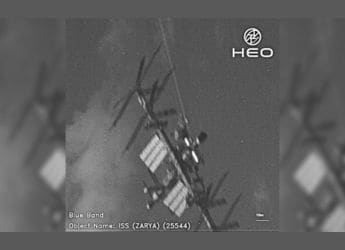- Home
- Others
- Others News
- In Texas schools, a picture's worth 1,000 calories
In Texas schools, a picture's worth 1,000 calories
By Associated Press | Updated: 5 June 2012 02:08 IST

Click Here to Add Gadgets360 As A Trusted Source

Advertisement
Smile, schoolchildren. You're on calorie camera.
Health officials trying to reduce obesity and improve eating habits at five San Antonio elementary schools unveiled a $2 million research project Wednesday that will photograph students' lunch trays before they sit down to eat and later take a snapshot of the leftovers.
A computer program then analyzes the photos to identify every piece of food on the plate -- right down to how many ounces are left in that lump of mashed potatoes -- and calculates the number of calories each student scarfed down.
The project, funded by a U.S. Department of Agriculture grant, is the first of its kind in the nation. The cameras, about the size of pocket flashlights, point only toward the trays and don't photograph the students. Researchers say about 90 per cent of parents gave permission to record every morsel of food their child eats.
"We're trying to be as passive as possible. The kids know they're being monitored," said Dr. Roger Echon, who works for the San Antonio-based Social & Health Research Center, and who is building the food-recognition program.
Here's how it works: Each lunch tray gets a bar code sticker to identify a student. After the children load up their plates down the line -- cole slaw or green beans? french fries or fruit? -- a camera above the cashier takes a picture of each tray.
When lunch is over and the plates are returned to the kitchen, another camera takes a snapshot of what's left. Echon's program then analyzes the before and after photos to calculate calories consumed and the values of 128 other nutrients. It identifies foods by measuring size, shape, color and density.
Parents will receive the data for their children, and researchers hope eating habits at home will change once moms and dads see what their kids are choosing in school. The data also will be used to study what foods children are likely to choose and how much they're eating.
Nine-year-old Aaliyah Haley went through the lunch line at W.W. White Elementary with cheesy enchiladas, Spanish rice, fat-free chocolate milk and an apple. Two cameras, one pointed directly down and another about tray-level, photographed her food before she sat down to eat.
"I liked it. It's good food that was good for me," Haley said.
Just how healthy it was researchers don't know yet. Echon is still developing the program and expects to spend the first year of the four-year grant fine-tuning the equipment. By the 2012-13 school year, the Social Health & Research Center plans to have a prototype in place.
Echon has already made some changes to the project. Echon learned that mashed potatoes served on some campuses are lumpier than those served on others. The program now accounts for consistencies and texture.
The database already includes about 7,500 different varieties of food. Echon said he started from scratch because there was no other food-recognition software to build upon. He insisted on creating technology to record meals because asking 8-year-olds to remember what they ate and write it down is seldom accurate.
Researches selected poor, minority campuses where obesity rates and diabetes risk are higher. Among those is White Elementary, which is just off a busy interstate highway on the city's poor east side, on a street dotted with fast-food restaurants and taquerias.
In Bexar County, where the five pilot schools are located, 33 per cent of children living in poverty are obese.
Researchers warn that obesity is not always the result of children eating too many calories. A previous study by the nonprofit center reported that 44 per cent of children studied consumed calories below daily minimum requirements, but nearly one-third were still obese. Seven per cent screened positive for type 2 diabetes.
Mark Davis, the school's principal, said getting consent from parents hasn't been a problem. He suspects the small number of parents who withhold consent don't understand the project, perhaps thinking it limits what their child can eat at school.
"Nothing in the program says they can't have something," Davis said. "It just says we're tracking what it is."
Health officials trying to reduce obesity and improve eating habits at five San Antonio elementary schools unveiled a $2 million research project Wednesday that will photograph students' lunch trays before they sit down to eat and later take a snapshot of the leftovers.
A computer program then analyzes the photos to identify every piece of food on the plate -- right down to how many ounces are left in that lump of mashed potatoes -- and calculates the number of calories each student scarfed down.
The project, funded by a U.S. Department of Agriculture grant, is the first of its kind in the nation. The cameras, about the size of pocket flashlights, point only toward the trays and don't photograph the students. Researchers say about 90 per cent of parents gave permission to record every morsel of food their child eats.
"We're trying to be as passive as possible. The kids know they're being monitored," said Dr. Roger Echon, who works for the San Antonio-based Social & Health Research Center, and who is building the food-recognition program.
Here's how it works: Each lunch tray gets a bar code sticker to identify a student. After the children load up their plates down the line -- cole slaw or green beans? french fries or fruit? -- a camera above the cashier takes a picture of each tray.
When lunch is over and the plates are returned to the kitchen, another camera takes a snapshot of what's left. Echon's program then analyzes the before and after photos to calculate calories consumed and the values of 128 other nutrients. It identifies foods by measuring size, shape, color and density.
Parents will receive the data for their children, and researchers hope eating habits at home will change once moms and dads see what their kids are choosing in school. The data also will be used to study what foods children are likely to choose and how much they're eating.
Nine-year-old Aaliyah Haley went through the lunch line at W.W. White Elementary with cheesy enchiladas, Spanish rice, fat-free chocolate milk and an apple. Two cameras, one pointed directly down and another about tray-level, photographed her food before she sat down to eat.
"I liked it. It's good food that was good for me," Haley said.
Just how healthy it was researchers don't know yet. Echon is still developing the program and expects to spend the first year of the four-year grant fine-tuning the equipment. By the 2012-13 school year, the Social Health & Research Center plans to have a prototype in place.
Echon has already made some changes to the project. Echon learned that mashed potatoes served on some campuses are lumpier than those served on others. The program now accounts for consistencies and texture.
The database already includes about 7,500 different varieties of food. Echon said he started from scratch because there was no other food-recognition software to build upon. He insisted on creating technology to record meals because asking 8-year-olds to remember what they ate and write it down is seldom accurate.
Researches selected poor, minority campuses where obesity rates and diabetes risk are higher. Among those is White Elementary, which is just off a busy interstate highway on the city's poor east side, on a street dotted with fast-food restaurants and taquerias.
In Bexar County, where the five pilot schools are located, 33 per cent of children living in poverty are obese.
Researchers warn that obesity is not always the result of children eating too many calories. A previous study by the nonprofit center reported that 44 per cent of children studied consumed calories below daily minimum requirements, but nearly one-third were still obese. Seven per cent screened positive for type 2 diabetes.
Mark Davis, the school's principal, said getting consent from parents hasn't been a problem. He suspects the small number of parents who withhold consent don't understand the project, perhaps thinking it limits what their child can eat at school.
"Nothing in the program says they can't have something," Davis said. "It just says we're tracking what it is."
Comments
Catch the latest from the Consumer Electronics Show on Gadgets 360, at our CES 2026 hub.
Popular on Gadgets
- Samsung Galaxy Unpacked 2025
- ChatGPT
- Redmi Note 14 Pro+
- iPhone 16
- Apple Vision Pro
- Oneplus 12
- OnePlus Nord CE 3 Lite 5G
- iPhone 13
- Xiaomi 14 Pro
- Oppo Find N3
- Tecno Spark Go (2023)
- Realme V30
- Best Phones Under 25000
- Samsung Galaxy S24 Series
- Cryptocurrency
- iQoo 12
- Samsung Galaxy S24 Ultra
- Giottus
- Samsung Galaxy Z Flip 5
- Apple 'Scary Fast'
- Housefull 5
- GoPro Hero 12 Black Review
- Invincible Season 2
- JioGlass
- HD Ready TV
- Laptop Under 50000
- Smartwatch Under 10000
- Latest Mobile Phones
- Compare Phones
Latest Gadgets
- OPPO A6 Pro 5G
- OPPO A6s
- OPPO Reno 15 Pro Max
- Honor Win RT
- Honor Win
- Xiaomi 17 Ultra Leica Edition
- Xiaomi 17 Ultra
- Huawei Nova 15
- Asus ProArt P16
- MacBook Pro 14-inch (M5, 2025)
- OPPO Pad Air 5
- Huawei MatePad 11.5 (2026)
- Xiaomi Watch 5
- Huawei Watch 10th Anniversary Edition
- Acerpure Nitro Z Series 100-inch QLED TV
- Samsung 43 Inch LED Ultra HD (4K) Smart TV (UA43UE81AFULXL)
- Asus ROG Ally
- Nintendo Switch Lite
- Haier 1.6 Ton 5 Star Inverter Split AC (HSU19G-MZAID5BN-INV)
- Haier 1.6 Ton 5 Star Inverter Split AC (HSU19G-MZAIM5BN-INV)
© Copyright Red Pixels Ventures Limited 2026. All rights reserved.












